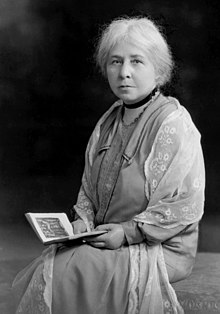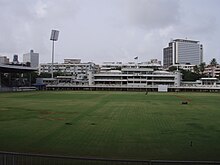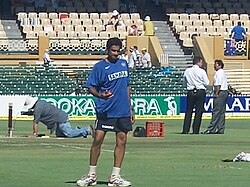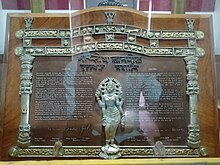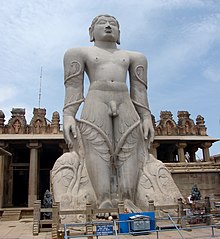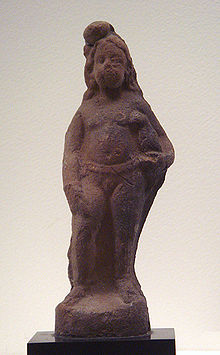Portal:India
Introduction


India, officially the Republic of India (ISO: Bhārat Gaṇarājya), is a country in South Asia. It is the seventh-largest country by area; the most populous country as of June 2023; and from the time of its independence in 1947, the world's most populous democracy. Bounded by the Indian Ocean on the south, the Arabian Sea on the southwest, and the Bay of Bengal on the southeast, it shares land borders with Pakistan to the west; China, Nepal, and Bhutan to the north; and Bangladesh and Myanmar to the east. In the Indian Ocean, India is in the vicinity of Sri Lanka and the Maldives; its Andaman and Nicobar Islands share a maritime border with Thailand, Myanmar, and Indonesia. (Full article...)
Selected pictures
Arikamedu is an archaeological site in Southern India, in Kakkayanthope, Ariyankuppam Commune, Puducherry. It is 4 kilometres (2.5 mi) from the capital, Pondicherry of the Indian territory of Puducherry.
Sir Mortimer Wheeler 1945, and Jean-Marie Casal conducted archaeological excavations there in 1947–1950. The site was identified as the port of Podouke, known as an "emporium" in the Periplus of the Erythraean Sea and Ptolemy. Digs have found Amphorae, Arretine ware, Roman lamps, glassware, glass and stone beads, and gems at the site. Based on these excavations, Wheeler concluded that the Arikamedu was a Greek (Yavana) trading post that traded with Rome, starting during the reign of Augustus Caesar, and lasted about two hundred years—from the late first century BCE to the first and second centuries CE. Subsequent investigation by Vimala Begley from 1989 to 1992 modified this assessment, and now place the period of settlement from the 2nd century BCE to the 8th century CE. (Full article...)
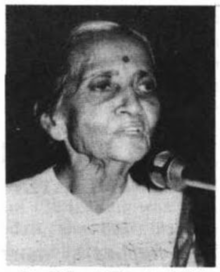
Congress Radio, also known as Azad Radio, was an underground radio station that operated for about three months during the Quit India Movement of 1942, a movement launched by Mahatma Gandhi against the British Raj for independence of India. Congress Radio was the broadcasting mouthpiece of the Indian National Congress and functioned from different locations in Bombay, present-day Mumbai, and briefly from Nashik. It was organized by Usha Mehta (1920–2000), then a 22-year student activist, with the help of amateur radio operators. Others who were involved included Vithalbhai Jhaveri, Vitthaldas Khakar, Chandrakant Jhaveri, and Babubhai Thakkar. The broadcasting equipment was supplied by Nanik Motwane of Chicago Radio, Bombay. Prominent leaders of the Indian independence movement like Ram Manohar Lohia, Achyutrao Patwardhan, and Purushottam Trikamdas were also associated with Congress Radio.
The radio station broadcast from 27 August through 12 November 1942 before being shut down by the authorities, with the operators being arrested. (Full article...)
The Tarakeswar affair (also known as the Tarakeswar scandal or the Mahant-Elokeshi affair) refers to a public scandal in 19th-century Bengal during the British Raj. It resulted from an illicit love affair between Elokeshi, the wife of a government employee Nobin Chandra, and the Brahmin head priest (or mahant) of the Tarakeswar Shiva temple. Nobin subsequently decapitated his wife Elokeshi because of the love affair. A highly publicised trial followed, dubbed the Tarakeswar murder case of 1873, in which both the husband and the mahant were found guilty in varying degrees.
Bengali society considered the mahant's actions as punishable and criminal, while justifying Nobin's action of killing an unchaste wife. The resulting public outrage forced authorities to release Nobin after two years. The scandal became the subject of Kalighat paintings and several popular Bengali plays, which often portrayed Nobin as a devoted husband. The mahant was generally presented as a womaniser, who took advantage of young women. The murder victim Elokeshi was sometimes blamed as a seductress and the root cause of the affair. In other plays, she was absolved of all guilt and was portrayed to have been tricked and raped by the mahant. (Full article...)
IIM Rohtak was established in the year 2010 as one of the six new IIMs announced under the 11th Five Year Plan. It offers mainly five courses, an Integrated Programs in Management (IPM), Integrated Program in Law (IPL), the Post-Graduate Program (PGP) in Management, Executive Post Graduate Program for Executives (EPGPX) and Doctoral Program in Management (DPM). (Full article...)
Wanting to make an unusual romance film, Anand struggled to find unconventional ideas while he was writing. His wife, Mamta, then came up with the core narrative of the film, which excited him and changed his perspective. Anand approached novelist Advaita Kala who developed the story into a feature-length script, and later co-wrote the screenplay with him. Principal photography was done entirely in New York City, Las Vegas and San Francisco. (Full article...)
Ranveer Singh Bhavnani (pronounced [rəɳˈʋiːr sɪŋ]; born 6 July 1985) is an Indian actor who works in Hindi films. He is the recipient of several awards, including five Filmfare Awards. He is among the highest-paid Indian actors and has been featured in Forbes India's Celebrity 100 list since 2012.
After graduating from Indiana University Bloomington, Singh worked in advertising for a few years. He made his acting debut with a leading role in Yash Raj Films' romantic comedy Band Baaja Baaraat (2010), winning the Filmfare Award for Best Male Debut. He gained praise for playing a melancholic thief in the drama Lootera (2013) and established himself as a star through his collaborations with Sanjay Leela Bhansali, beginning with Goliyon Ki Raasleela Ram-Leela (2013). He portrayed Bajirao I and Alauddin Khilji in Bhansali's period dramas Bajirao Mastani (2015) and Padmaavat (2018), respectively. He won the Filmfare Award for Best Actor for the former and the Filmfare Critics Award for Best Actor for the latter. (Full article...)
The Khalji Revolution, alternatively spelled the Khilji Revolution, marked a military coup and a period of political and societal transformation in the Delhi Sultanate. It unfolded following the death of Mamluk sultan Balban and the subsequent incapacity of his successors to effectively govern the Delhi Sultanate. The upheaval commenced and concluded in 1290 when Jalaluddin Khalji seized absolute power, toppling the Mamluks and inaugurating the rule of the Khalji dynasty.
After Balban's death, his underage grandson Qaiqabad ascended the throne. A poor governor, Qaiqabad later fell ill and became paralyzed, leading to the succession of his son, Shamsuddin Kayumars. Amidst this upheaval, factions arose within the Mamluk court, with the Turkic faction led by Aitmar Surkah facing off against the Khalji faction, led by Jalaluddin Khalji. (Full article...)
Pitru Paksha (Sanskrit: पितृ पक्ष, lit. '"fortnight of the paternal ancestors"', IAST: Pitṛ pakṣa), also spelt Pitri Paksha, is a 16-lunar day period in the Hindu calendar when Hindus pay homage to their ancestors (Pitrs), especially through food offerings. The period is also known as Pitri Paksha/Pitr-Paksha, Pitri Pokkho, Sorah Shraddha ("sixteen shraddhas"), Kanagat, Jitiya, Mahalaya, Apara Paksha and akhadpak.
Pitru Paksha is considered by Hindus to be inauspicious, given the death rite performed during the ceremony, known as Shraddha or Tarpana. In southern and western India, it falls in the second paksha (fortnight) Hindu lunar month of Bhadrapada (September) and follows the fortnight immediately after Ganesh Utsav. It begins on the Pratipada (first day of the fortnight) ending with the no moon day known as Sarvapitri Amavasya, Pitri Amavasya, Peddala Amavasya or Mahalaya Amavasya (simply Mahalaya) Most years, the autumnal equinox falls within this period, i.e. the Sun transitions from the northern to the southern hemisphere during this period. In North India and Nepal, and cultures following the purnimanta calendar or the solar calendar, this period may correspond to the waning fortnight of the luni-solar month Ashvina, instead of Bhadrapada. (Full article...)
Buddhaghosa was a 5th-century Indian Theravada Buddhist commentator, translator and philosopher. He worked in the Great Monastery (Mahāvihāra) at Anurādhapura, Sri Lanka and saw himself as being part of the Vibhajjavāda school and in the lineage of the Sinhalese Mahāvihāra.
His best-known work is the Visuddhimagga ("Path of Purification"), a comprehensive summary of older Sinhala commentaries on Theravada teachings and practices. According to Sarah Shaw, in Theravada this systematic work is "the principal text on the subject of meditation." The interpretations provided by Buddhaghosa have generally constituted the orthodox understanding of Theravada scriptures since at least the 12th century CE. (Full article...)
There were initially several concerns in the Indian media that it could not live up to the high standards and success of the original. Production of the film began in 2011, with the principal photography taking place in Cape Town, Goa and Mumbai on a budget of ₹18 crore (US$2.2 million). (Full article...)
The encyclopedic treatise is structured as five sub-books with a cumulative total of 100 chapters. It is notable for its extensive discussion of arts, particularly music and dance. It is also notable for including chapters on food recipes and festivals, many of which are a part of modern Indian culture. (Full article...)
Tripathi had confirmed in September 2011 that he was writing The Oath of the Vayuputras, with Westland announcing the release date as 27 February 2013. The book was longer than the previous installments of the series and Tripathi clarified that all the loose ends left out in the previous book would be addressed, with the death of certain characters. Following the release of the cover art, it was announced that the publication rights of the books have been bought by both US and UK publisher houses. Like The Immortals of Meluha and The Secret of the Nagas, the book contained innovative marketing techniques, including launching interactive apps, merchandise and a music album titled Vayuputras, containing music inspired by different events in the series. (Full article...)
News
- 19 July 2024 –
- WazirX, an Indian cryptocurrency exchange owned by Binance, announces a security breach in which $234 million USD in cryptocurrency was stolen, amounting to half of the platform's total assets. (Business Standard)
- 18 July 2024 – Naxalite–Maoist insurgency
- Two Indian soldiers are killed and four others are injured in an IED attack by Maoists in Chhattisgarh, India. (The Hindustan Times) (India Blooms)
- 17 July 2024 –
- Comoros-flagged oil tanker Prestige Falcon capsizes off the coast of Oman. The Indian Navy rescues nine crew members, with seven others missing. (AP)
- 13 July 2024 –
- The Guardia di Finanza frees 33 Indian farm workers from exploitative conditions in Verona, Veneto, Italy, and seizes nearly €500,000 (US$545,000) from two Indian individuals accused of charging workers €17,000 ($18,500) each for permits. (AP)
- 8 July 2024 – India–Russia relations
- Indian Prime Minister Narendra Modi visits Moscow, Russia, for the first time since the start of the Russian invasion of Ukraine. (Al Jazeera)
Did you know...
- ... that the name of the Indian city Bangalore could be derived from a Kannada word meaning 'town of boiled beans'?
- ... that Zakir Husain was the first Muslim and the first governor of a state to be elected President of India?
- ... that the colonial enslavement of American Indians is described as a cultural genocide?
- ... that Hindu religious leader Siddeshwar Swami declined the Padma Shri, India's fourth-highest civilian honor?
- ... that in 2022 Sandhya Dhar has received both a Nari Shakti Puraskar and a bronze medal in boccia at the Indian national championships?
- ... that the Canadian House of Commons held a take-note debate on the discovery of the graves of more than 200 Indigenous children near Kamloops Indian Residential School in 2021?
Topics related to India
Timeline of Indian history, Indus Valley Civilisation, Dholavira, Science and technology in ancient India, Meluhha, Aryan invasion theory, Out of India theory, Greek conquests in India, Indian maritime history, Maurya Empire, Ashoka, Shunga Empire, Hoysala Empire, Vijayanagara, Satavahana dynasty, Indo-Greek Kingdom, Indo-Scythians, Indo-Parthian Kingdom, Kushan Empire, Western Satraps, Gupta Empire, Chola dynasty, Pala Empire, Islamic incursions in India, Mughal Empire, Maratha Empire, British Raj, East India Company, Governor-General, Viceroy, War of Independence, 1857, Indian independence movement, Indian National Army, Azad Hind, Quit India Movement, Partition of India, History of Republic of India, Non-Aligned Movement, Sino-Indian War, Indo-Pakistani War of 1947–1948, Indo-Pakistani War of 1965, Indo-Pakistani War of 1971, Kargil War, 2001–02 India–Pakistan standoff, Military, Demographic
Law, Hindu law, Constitution, Political parties (Indian National Congress, Bharatiya Janata Party), Foreign relations, Elections, Political divisions, Reservation in India
Government agencies, Legislative branch (Lok Sabha, Rajya Sabha) Executive branch (President & Vice President, Prime Minister & Deputy Prime Minister, Cabinet Ministers, Cabinet Secretary, Election Commission, Foreign Minister; Law enforcement: CBI, CID, Intelligence: IB, RAW), Directorate General of Income Tax Investigation Judicial branch (Supreme Court), Armed Forces (Army, Navy, Air Force, Border Security Force, Coast Guard)
Himalayas, Western Ghats, Eastern Ghats, Indo-Gangetic Plain, Deccan Plateau, Thar Desert, Ganges, Rann of Kutch, Brahmaputra River, Northeast India; Mountains, Valleys, Islands, Rivers; States and union territories, Cities, Districts, Regions, Fauna, Flora
Rupee, Bombay Stock Exchange, National Stock Exchange, Standard of living, Companies, Reserve Bank of India, Energy policy (Solar, Wind, Nuclear), Tourism, Transport (Expressways, Rail transport, Auto rickshaw),
Languages, Standard of living, Religion
Music (Carnatic, Hindustani, Indi-pop), Dance, Languages, Literature, Architecture, Film & TV, Cuisine, Holidays, Folklore, Education, Media, Indian martial arts
Indian Council of Agricultural Research (ICAR), Indian Institute of Astrophysics, National Centre for Software Technology, AIIMS, IISc, IIT, NIT, BITS-Pilani, INRegistry, Indian numbering system, Indian Space Research Organisation, National Internet Exchange of India, ICRISAT, International Institute of Information Technology, Hyderabad
Indian English, Indian nationality law, Numbering system, Indian Space Research Organisation, Telecommunications, National Highways Development Project, Flag, Vehicle registration plates, Indian nationalism, Metrication in India
Categories
Related portals
Religions in India
Indian Subcontinent
Other countries
Wikipedias in Indian languages
- অসমীয়া (Assamese)
- বাংলা (Bengali)
- भोजपुरी (Bhojpuri)
- বিষ্ণুপ্রিয়া মণিপুরী (Bishnupriya Manipuri)
- गोंयची कोंकणी / Gõychi Konknni (Konkani)
- ગુજરાતી (Gujarati)
- हिन्दी (Hindi)
- ಕನ್ನಡ (Kannada)
- कॉशुर/كشميري (Kashmiri)
- मैथिली (Maithili)
- മലയാളം (Malayalam)
- मराठी (Marathi)
- नेपाली (Nepali)
- नेपाल भाषा
- (Newari)
- ଓଡ଼ିଆ (Odiya)
- ਪੰਜਾਬੀ (Punjabi)
- पालि (Pali)
- संस्कृत (Sanskrit)
- ᱥᱟᱱᱛᱟᱲᱤ (Santali)
- سنڌي (Sindhi)
- தமிழ் (Tamil)
- తెలుగు (Telugu)
- ತುಳು (Tulu)
- اردو (Urdu)
Associated Wikimedia
The following Wikimedia Foundation sister projects provide more on this subject:
-
Commons
Free media repository -
Wikibooks
Free textbooks and manuals -
Wikidata
Free knowledge base -
Wikinews
Free-content news -
Wikiquote
Collection of quotations -
Wikisource
Free-content library -
Wikiversity
Free learning tools -
Wikivoyage
Free travel guide -
Wiktionary
Dictionary and thesaurus


![Image 1 Mukerji promoting Hichki in 2018 Rani Mukerji (pronounced [raːni mʊkʰərdʒi]; born 21 March 1978) is an Indian actress who works in Hindi films. Noted for her versatility, she is the recipient of multiple accolades, including eight Filmfare Awards. Mukerji has featured in listings of the leading and highest-paid actresses of the 2000s. Born into the Mukherjee-Samarth family, Mukerji dabbled with acting as a teenager by starring in her father Ram Mukherjee's Bengali-language film Biyer Phool and in the social drama Raja Ki Aayegi Baaraat (both 1996). Mukerji had her first commercial success with the action film Ghulam and breakthrough with the romance Kuch Kuch Hota Hai (both 1998). Following a brief setback, the year 2002 marked a turning point for her when she was cast by Yash Raj Films as the star of the drama Saathiya. (Full article...)](http://upload.wikimedia.org/wikipedia/en/d/d2/Blank.png)



